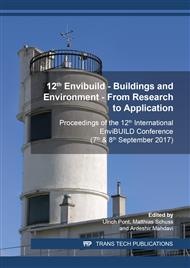p.511
p.519
p.527
p.539
p.547
p.553
p.561
p.571
p.579
Low Frequency Noise Level Assessment in Vienna
Abstract:
The present contribution reports on the results of sound level measurements in a number of locations in the city of Vienna, Austria. Thereby, a primary objective was to determine the degree to which the measurement results agree with corresponding information in the E.N.D. (Environmental Noise Directive 2002/49/EC) maps. Moreover, the relationship between the low-frequency segment of the acoustical exposure to the broad-band data was investigated. The results point to traffic as the main source of urban noise exposure. E.N.D. maps appear to provide a reasonable general overview of the urban noise circumstances. However, measurement results at individual locations can considerably deviate from E.N.D. data. Numeric values of low-frequency sound level range were found to be generally higher than those of the broad-frequency levels. The results revealed also a strong correlation between measurement-based L50R and NR (Noise Rating) values.
Info:
Periodical:
Pages:
547-552
Citation:
Online since:
January 2019
Authors:
Price:
Сopyright:
© 2019 Trans Tech Publications Ltd. All Rights Reserved
Share:
Citation:


